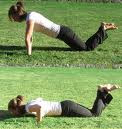Q: I recently lost over 100lbs. My arms are a lot skinnier, of course, but since the weight loss was done by counting calories and cardiovascular workouts done doing Dance Dance Revolution and then on a stationary bike, my upper body is much weaker than it was before the weight loss. What can I do to gain upper body strength?
A: Congratulations on the weight loss…that’s amazing! You’re question is great. Strength training is an extremely important component every day health. As you’ve experienced, when strength training is not involved in a weight loss program, you could be left with weaker muscles than before, especially in the upper body. The benefits of strength training are vast and valuable. Strength training:
· Increases your lean body tissue
· Boosts metabolism
· Helps balance and coordination
· Improves the symptoms and can reverse arthritis, osteoporosis, back pain and much more
· Prevents Sarcopenia, which is just a fancy word for losing muscle mass as we age.
Studies show that we start losing muscle mass at a rate of 1% a year staring in our 30s and 40s. So what? Well, it’s a big deal to lose muscle mass. Not only will you have a higher percentage of body fat which puts stress on your heart, can lead to diabetes and some other horrible things, but keeping your muscles means keeping your balance, preventing osteoporosis, and sustaining our abilities to do every day tasks well into the aging process. Specifically, upper body strength lets us do every day tasks such as carrying groceries, lifting kids, putting things up on shelves, helping friends and family move, and getting up and down off of the floor. You don’t have to train like a body builder to get a strong, functional upper body. In fact, to get started you don’t need any equipment; you can just use your own body weight to start getting strong, lean muscle mass.
Check out these 2 upper body strengtheners that you can do anywhere. The key to gaining strength is to push your body and progress through the levels. Start at the level in which you can barely finish the 12th repetition. Once you are able to do 15 reps, move to the next level. Every other day, do 3 sets of push ups and tricep dips. (12 repetitions per set).
 Push Ups. Most people think that this is an advanced move for only the super-strong. Push ups are hard, but you can ease your way into this upper body strength builder. Push ups are a must move because they use pretty much all the muscles in the upper body (arms, chest, back) making it an extremely efficient upper body exercise.
Push Ups. Most people think that this is an advanced move for only the super-strong. Push ups are hard, but you can ease your way into this upper body strength builder. Push ups are a must move because they use pretty much all the muscles in the upper body (arms, chest, back) making it an extremely efficient upper body exercise.
Level 1: Using a wall, stand with feet hip width apart a few feet out from the wall. Keeping the abs in tight and torso straight, lean towards the wall and place hands chest height, slightly wider than shoulder width apart. Slowly bring your chest towards the wall and then slowly push back up to starting position. Repeat 12 times.
Level 2: Use a counter or sturdy table edge and follow the Level one instructions.
Level 3: On the floor, either on your knees or toes, keep your body nice and flat as you lower your chest towards the ground and push back up. Need more? Lift one leg up as you go down.
 Tricep Dips. Dips are a great functional exercise that strengthens your shoulders and triceps.
Tricep Dips. Dips are a great functional exercise that strengthens your shoulders and triceps.
Level 1: Find a sturdy (non-rolling chair). Take a seat on the edge of the chair and place the hands on either side of your thighs, curling your fingers around the front seat of the chair. With elbows bent, lift your rear end off the chair until your arms are straight. Lower back down to seated. Repeat 12 times. This is a tiny movement, but it will prepare you for the next levels.
Level 2: Start in the same position as before. Your legs should be bent at a ninety degree angle with the feet flat on the floor. Lift your rear up off the chair, walk the feet out a bit so that your hips are in front of the chair instead of directly over it. Slowly bend your elbows until they are at a ninety degree angle and then push yourself back up until your arms are straight. Repeat 12 times.
Level 3: Same as Level 2 only your legs are straight out in front of the chair, not bent. If you need something more than that, lift a leg.
Enjoy!



